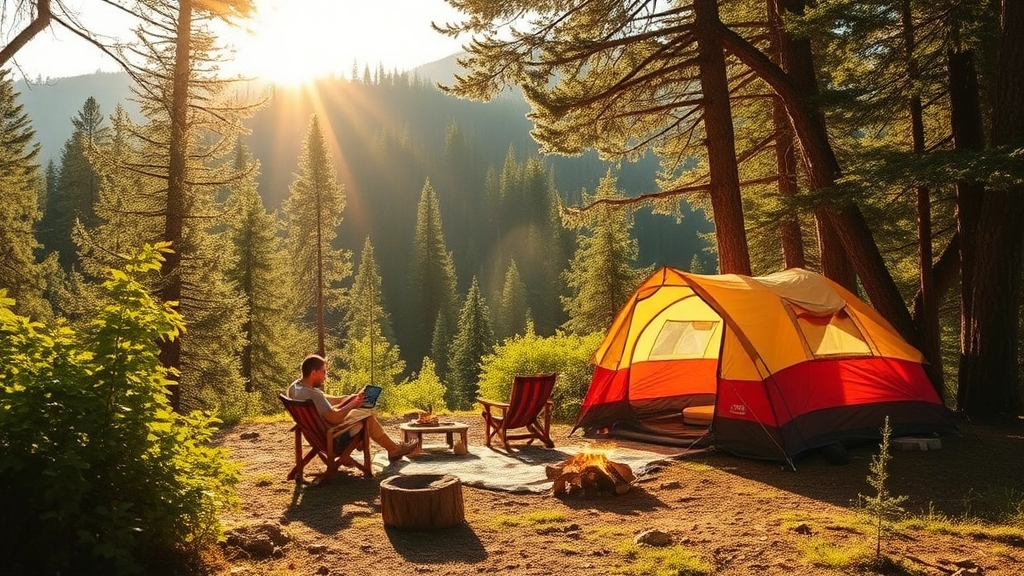Camping in summer heat can be a challenge, but with the right strategies, it can also be an enjoyable and refreshing experience. This article will guide you through essential tips for staying cool and comfortable, from choosing the best campsite to managing physical activity during peak heat. We’ll also cover essential gear, hydration techniques, and creative cooling methods to ensure your summer camping trip is a breeze.
You’ll learn how to set up your tent for maximum ventilation, select the right clothing, and even create DIY air conditioning. We’ll also delve into the importance of food and hydration in heat regulation, and how to cook safely without adding extra heat. Whether you’re a seasoned camper or a newbie, these tips will help you beat the heat and make the most of your summer camping adventures.
Choosing the Best Campsite for Hot Weather
Alright, let’s dive into a common dilemma we all face: choosing the best campsite for hot weather. When the sun’s blazing and the air feels like an oven, the last thing you want is to set up camp in a spot that makes you feel like a roasted marshmallow. Here’s how you can avoid that sticky situation and find a cool, comfortable campsite.
Why Location Matters
First thing’s first â location is key. You wouldn’t want to pitch your tent in the middle of a sun-drenched field, right? Here are some real questions and worries you might have:
- “How can I avoid the heat?”
- “Is there a way to stay cool while camping?”
- “What should I look for in a campsite during hot weather?”
These are all valid concerns, and trust me, I’ve been there too. Let’s break it down.
What to Look For
1. Shade, Shade, Shade:
- Tree cover: Look for campsites with plenty of trees. They act like nature’s air conditioning, blocking out direct sunlight and keeping the area cooler.
- Natural features: Hills, rocks, or any other natural features that can cast shade are your friends.
2. Elevation:
- Higher ground: Campsites at higher elevations tend to be cooler. If you have the option, go for a spot that’s a bit elevated.
- Valleys: Be cautious with valleys; they can trap heat and reduce airflow.
3. Water Sources:
- Near water: Camping near a lake, river, or stream can significantly cool the surrounding area. Plus, it gives you easy access to water activities to cool off.
- Breezes: Water bodies often bring breezes that can help lower the temperature.
4. Ground Surface:
- Grass vs. dirt: A grassy campsite is cooler than a dirt one. Grass doesn’t absorb as much heat, making it a more comfortable surface to camp on.
5. Wind Direction:
- Open to breezes: Choose a site that’s open to prevailing winds. This helps with ventilation and keeps the air moving, which is crucial in hot weather.
Personal Experience
I remember one summer camping trip where I ignored all these tips and ended up in a sun-baked spot with no shade. By midday, the tent felt like a sauna, and I was constantly battling dehydration. Lesson learned: always scout for the coolest spot possible.
Internal Linking Opportunities
If you’re thinking about how to stay hydrated and keep cool, check out our section on staying cool and comfy. And don’t miss our tips on fun activities to keep you engaged, which can make a huge difference in your comfort level.
Essential Gear for Summer Camping Comfort
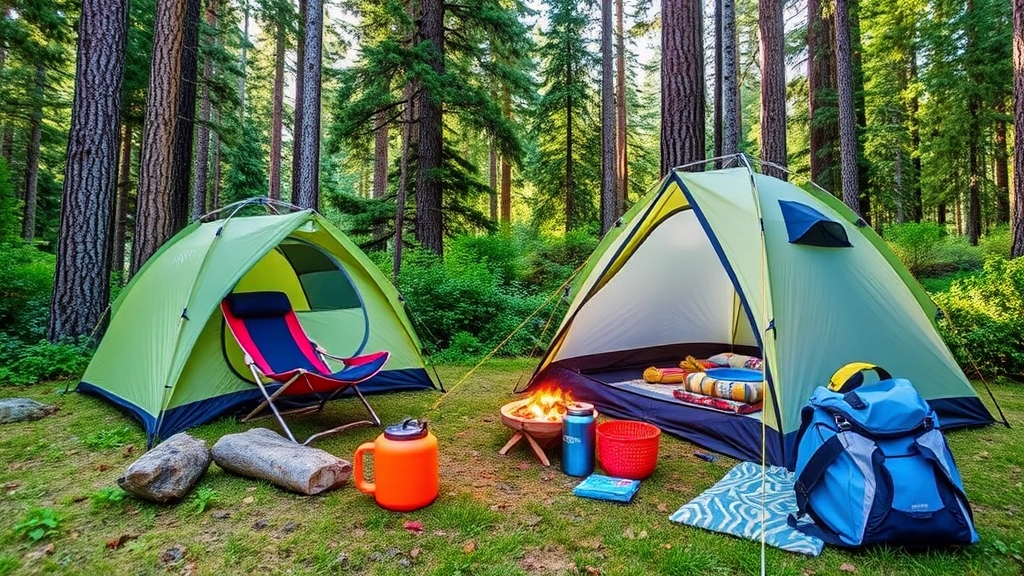
Let’s be real, summer camping can be a sweaty mess if you’re not prepared.
Ever found yourself tossing and turning in a tent that feels like a sauna? Yeah, me too.
Here’s the lowdown on the essential gear you need to stay cool and comfy when camping in hot weather.
Must-Have Gear for Hot-Weather Camping
First things first, lightweight tents are a game-changer.
You want something with plenty of ventilation.
Look for tents with mesh panels and large windows.
Trust me, airflow is your best friend.
Sleeping Gear That Keeps You Cool
Next up, sleeping bags.
Ditch the heavy-duty, winter ones.
Opt for a lightweight, breathable sleeping bag or even a sleeping bag liner.
Sometimes, a simple sleeping pad and a light blanket can do wonders.
Portable Fans and Ventilation
A battery-operated fan can be your saviour.
Clip it to your tent and let it circulate that precious air.
Some fans even come with built-in LED lights, killing two birds with one stone.
Hydration Solutions
A hydration pack or a large water bottle is non-negotiable.
Staying hydrated is crucial (more on that in the next section).
Sun Protection
Don’t forget a good hat and sunglasses.
A wide-brimmed hat can keep the sun off your face and neck.
And, of course, sunscreen.
You don’t want to end up looking like a lobster.
Cooking Gear
When it comes to cooking, a portable stove is your best bet.
It keeps the heat away from your tent and cooking area.
Plus, it’s way more efficient than a campfire.
Cooling Gadgets
Ever heard of a cooling towel?
Just wet it, wring it out, and snap it.
It stays cool for hours.
Perfect for those scorching afternoons.
Real Talk: My Experience
I remember this one time, camping in the Peak District, the heat was unbearable.
My battery-operated fan and cooling towel were lifesavers.
Trust me, it’s the little things that make a big difference.
Quick Recap
- Lightweight tents with ventilation
- Breathable sleeping bags or liners
- Battery-operated fans
- Hydration packs
- Sun protection gear
- Portable stoves
- Cooling towels
You don’t need to break the bank to stay cool.
Just a few smart choices can turn a miserable, sweaty night into a comfortable, relaxing experience.
Ready to gear up for your next summer camping trip?
You’ve got this!
Staying Hydrated: How and Why It Matters
Ever been on a summer camping trip and felt like you were melting under the sun? Yeah, we’ve all been there. Staying hydrated isn’t just a good idea; it’s your lifeline out there. So, why does hydration matter so much, and how can you keep those water levels up? Let’s break it down.
Why Hydration Matters
When you’re out in the wild during summer, your body is working overtime to keep you cool. That means sweatingâa lot. And with every drop of sweat, you’re losing water and essential salts. If you don’t replace these, you’re looking at dehydration. Trust me, you don’t want to go there. Dehydration can lead to:
- Fatigue: You won’t have the energy to enjoy your trip.
- Heatstroke: This can be serious and even life-threatening.
- Headaches and dizziness: Not fun when you’re trying to navigate a trail.
How to Stay Hydrated
Now, let’s talk about how to keep that hydration game strong.
Drink Water Regularly
Seems obvious, right? But you’d be surprised how many people forget to sip throughout the day. Make it a habit:
- Carry a reusable water bottle: Always have it within reach.
- Set reminders: Use your phone to remind you to drink every 30 minutes.
- Drink before you’re thirsty: Thirst is a late sign of dehydration.
Electrolyte Solutions
Water is great, but sometimes you need a little extra. Electrolyte solutions can help:
- Sports drinks: These can replace lost salts.
- DIY options: Mix water with a pinch of salt and a splash of fruit juice.
Eat Hydrating Foods
Food can be a sneaky way to stay hydrated. Pack snacks that have high water content:
- Fruits: Watermelon, oranges, and strawberries.
- Veggies: Cucumbers, celery, and tomatoes.
Avoid Dehydrators
Some things can dehydrate you faster than you can say “sunburn”:
- Alcohol: Save the beers for after the hike.
- Caffeine: Keep coffee and energy drinks to a minimum.
Real Talk: Stories from the Trail
I remember one trip where my mate thought he could get by on just a couple of bottles of water for a whole day hike. By noon, he was dragging his feet, and by 2 PM, he was flat out on the ground. We had to cut the hike short and get him back to camp for some serious rehydration. Lesson learned: You can’t mess around with hydration.
Link Up
For more tips on choosing the best campsite to beat the heat, check out our Top Tips for Summer Tent Camping. And if you’re curious about how food plays a role in staying cool, don’t miss our section on Summer Camp Cooking Classes for Kids & Teens.
Using Ventilation and Fans for Airflow in Tents
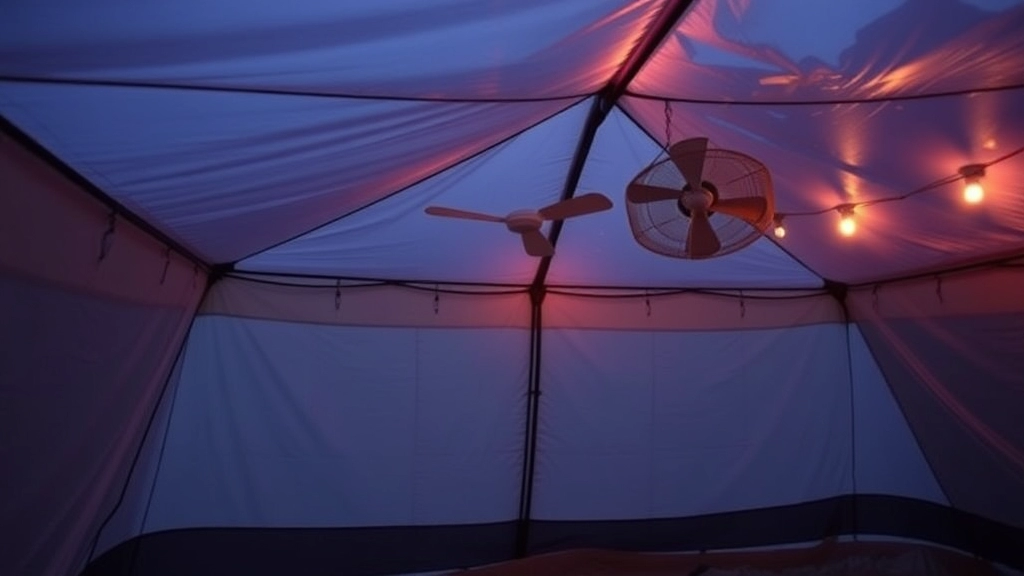
Ever been in a tent that feels like a sauna? I have, and it’s not fun.
The keyword here is ventilation.
Without it, you’re basically roasting yourself in a fabric oven.
So, how do we get that sweet, sweet airflow?
First off, choose a tent with plenty of mesh panels.
These allow air to circulate while keeping bugs out.
Look for tents with multiple windows and vents.
Set up your tent in the right spot.
Find a shady area, ideally where a breeze can flow through.
If you’re near water, even better.
Water bodies tend to cool the air around them.
Use a fan inside your tent.
Battery-operated fans are a lifesaver.
Place them strategically to direct airflow where you need it most.
Prop up the rainfly.
If it’s not going to rain, lift the rainfly to let more air in.
Open all the doors and windows during the day.
This lets hot air escape and cooler air enter.
Real Talk: Personal Stories and Tips
I remember camping in the Lake District during a heatwave.
I didn’t have a fan, and my tent was like a furnace.
A fellow camper loaned me a battery-operated fan, and it was a game-changer.
I also learned to hang a damp cloth in front of the fan.
Instant DIY air conditioning.
Quick Tips:
- Mesh Panels: More is better.
- Location: Shade and breeze are your friends.
- Fans: Battery-operated for the win.
- Rainfly: Lift it if you can.
- Windows and Doors: Keep them open.
Why It Matters
Proper ventilation keeps you cool and prevents condensation.
No one wants to wake up in a soggy sleeping bag.
Plus, good airflow helps you sleep better, and that’s crucial when you’re out in the wild.
Sleeping Strategies for Hot Nights
Alright, let’s dive right into it. How many times have you been camping in the summer, only to toss and turn all night because it’s just too darn hot? Yeah, I’ve been there too. So, let’s talk about some practical sleeping strategies for those scorching nights.
Choose the Right Sleeping Gear
One of the first things you need to consider is your sleeping gear. Make sure you have a lightweight sleeping bag and a breathable tent. If you’re unsure about what to pack, check out our 1-week summer camp packing list essentials for some great tips.
Stay Hydrated
Hydration is key to staying cool at night. Drinking plenty of water throughout the day helps regulate your body temperature. For more tips on staying safe and having fun, especially around water, take a look at our guide on summer camp swimming fun, safety, and tips.
Clothing Tips: Fabrics and Colours That Keep You Cool

Ever been stuck in a tent, sweating buckets, wondering if your clothing choice is to blame?
Yeah, we’ve all been there.
Choosing the right clothes for summer camping can make a world of difference.
So, let’s dive into it.
Why Your Clothing Matters
First off, your clothes can either be your best mate or your worst enemy in hot weather.
Fabrics and colours play a huge role in keeping you cool.
Here’s what you need to know.
Fabrics That Work for You
- Cotton: Breathable, but not the best for wicking away sweat.
- Linen: Super breathable and dries quickly.
- Synthetic Blends: Look for moisture-wicking options like polyester.
- Merino Wool: Yes, wool! It’s lightweight and great at regulating temperature.
I remember one trip where I switched from cotton to a synthetic blend.
Game changer.
I felt cooler and more comfortable throughout the day.
Colours That Keep You Cool
Dark colours absorb heat.
Light colours reflect it.
Simple, right?
So, go for whites, light blues, and pastels.
Practical Tips for Choosing Clothes
- Layer Up: Even in hot weather, layering can help. A light, breathable base layer can wick sweat away.
- Loose Fit: Tight clothes trap heat. Loose clothes allow air to circulate.
- Hats: A wide-brimmed hat can keep the sun off your face and neck.
Real Talk: What to Pack
Here’s a quick list of what I usually pack for a summer camping trip:
- 2-3 light-coloured T-shirts (synthetic blend or linen)
- 1 pair of lightweight trousers (synthetic blend)
- 1 pair of shorts
- A wide-brimmed hat
- A light, long-sleeve shirt for evenings
Quick Story
Last summer, I went camping with a mate who ignored all these tips.
He wore a black cotton T-shirt and jeans.
By midday, he was a sweaty mess.
Meanwhile, I was cool and comfy in my linen shirt and light-coloured shorts.
Managing Physical Activity During Peak Heat
Ever tried to hike up a hill at noon during summer and felt like you were melting? Yeah, me too. Managing physical activity during peak heat is no joke and can make or break your camping experience. So, how do we keep it cool and safe?
Why It Matters
First off, let’s get real. Overexertion in high temperatures can lead to heat exhaustion or even heat stroke. Trust me, you don’t want to be that person who needs rescuing because they pushed too hard. So, managing physical activity during peak heat is crucial for your health and enjoyment.
Time Your Activities
Early Morning or Late Afternoon:
- Why? The temperatures are cooler, and the sun isn’t as intense.
- What to do? Plan hikes, set up camp, or do any strenuous activities during these times.
Midday Rest:
- Why? This is when the sun is at its peak, and the heat can be unbearable.
- What to do? Find shade, relax, and hydrate. Maybe even take a nap or read a book.
Stay Hydrated
You’ve heard it a million times, but staying hydrated is non-negotiable.
- Water Bottles: Carry them everywhere. Aim for at least 2-3 litres a day.
- Electrolytes: Add electrolyte tablets or drinks to your routine to replenish lost salts.
Dress Smart
Lightweight and Breathable Fabrics:
- Why? These fabrics wick away sweat and allow your skin to breathe.
- Examples: Think cotton, linen, or moisture-wicking synthetic materials.
Light Colors:
- Why? Dark colors absorb heat, while light colors reflect it.
- What to wear? Whites, pastels, or any light shades.
Pace Yourself
Slow and Steady:
- Why? Overexertion can quickly lead to heat-related illnesses.
- How? Take frequent breaks, and don’t be a hero. Listen to your body.
Buddy System:
- Why? Having someone to watch your back can be a lifesaver.
- How? Keep an eye on each other for signs of overheating like excessive sweating, dizziness, or confusion.
Cooling Techniques
Wet Towels:
- Why? Placing a wet towel on your neck can quickly lower your body temperature.
- How? Soak a small towel in cold water, wring it out, and drape it around your neck.
Portable Fans:
- Why? They provide instant relief and improve airflow.
- How? Battery-operated or hand-crank fans work great.
Real Talk
I remember one summer camping trip where I thought I could handle a midday hike. Big mistake. I ended up feeling dizzy and had to cut it short. Learned my lesson the hard way. Now, I stick to early morning hikes and spend the hottest part of the day chilling in the shade with a cold drink.
Internal Links
Want more tips on staying cool? Check out our guide on Staying Cool and Comfortable During Tent Camping and discover the Essential Clothing Tips for Summer Camp.
Creative Cooling Techniques: DIY Air Conditioning
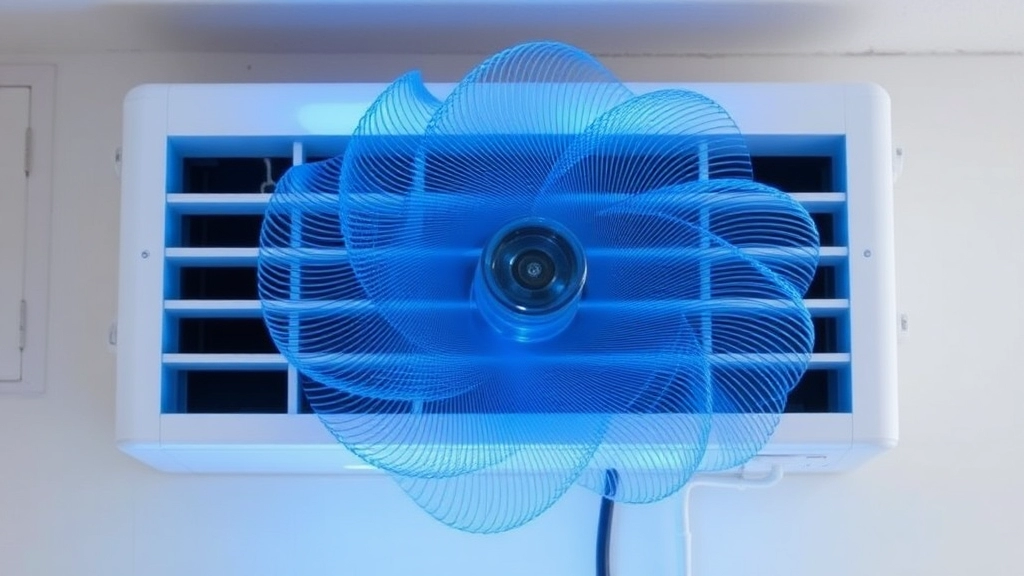
Ever tried sleeping in a tent when it’s hotter than a sauna? Yeah, not fun.
So, how do you keep cool without splurging on fancy gear?
Let’s dive into some DIY air conditioning hacks.
Why DIY Air Conditioning?
First off, why bother with DIY air conditioning?
Because no one wants to feel like they’re roasting in their own sweat.
Keeping your tent cool can make or break your camping trip.
And trust me, you don’t need to break the bank to do it.
Ice Packs and Fans
One of the simplest tricks?
Ice packs and a portable fan.
- Grab a few ice packs from your cooler.
- Place them in front of a battery-operated fan.
- Aim the fan towards your sleeping area.
The fan blows the cool air from the ice packs around your tent.
Instant relief.
The Damp Towel Trick
Here’s another gem:
Damp towels.
- Soak a towel in cold water.
- Wring it out so it’s damp, not dripping.
- Hang it up inside your tent.
As the water evaporates, it cools the air.
Simple science, big impact.
Reflective Tarps
Ever thought about using a reflective tarp?
- Set up a reflective tarp over your tent.
- Make sure there’s a gap between the tarp and the tent for airflow.
This deflects the sun’s rays and keeps your tent cooler.
Frozen Water Bottles
Another quick fix?
Frozen water bottles.
- Freeze some water bottles before your trip.
- Place them around your tent.
As they melt, they’ll cool the air.
Plus, you get cold water to drink later. Win-win.
Ventilation is Key
Don’t forget about ventilation.
- Open up all the windows and vents in your tent.
- Set up your tent to catch any breeze.
Proper airflow can make a world of difference.
Real-Life Example
I remember a trip last summer.
The heat was unbearable.
We used ice packs and a fan, hung up damp towels, and had reflective tarps.
It felt like a different world inside our tent compared to outside.
The Role of Food and Hydration in Heat Regulation
Alright, let’s get real for a moment. When you’re out camping in the blistering heat, what you eat and drink can make or break your experience. Ever felt like you’re melting into a puddle of sweat because you didn’t think your food and hydration through? Yeah, we’ve all been there. Let’s dive into how to stay cool and hydrated without making it complicated.
Why Food and Hydration Matter
Hydration isn’t just about quenching your thirst. It’s about keeping your body’s cooling system running efficiently. Water helps regulate your body temperature, which is crucial when you’re out in the sun all day. And food? Well, the right choices can keep you energised without overheating.
Hydration Hacks for Hot Weather
- Water, Water, Water: Obvious, but worth repeating. Drink water regularly, not just when you’re thirsty. Dehydration can sneak up on you.
- Electrolytes: When you sweat, you lose more than just water. Replenish those electrolytes with sports drinks or electrolyte tablets. Coconut water’s a natural alternative.
- Infused Water: Add some slices of cucumber, mint, or citrus fruits to your water. It’s refreshing and makes you want to drink more.
Food Choices That Help You Stay Cool
Now, let’s talk food. You don’t want to be cooking up a storm and adding more heat to your already sweltering environment. Here’s what you should focus on:
- Fresh Fruits and Veggies: High water content foods like watermelon, cucumbers, and oranges not only hydrate you but also keep you cool.
- Light Meals: Opt for salads, wraps, and other light meals. Heavy, greasy foods can make you feel sluggish and even hotter.
- Avoid Spicy Foods: As much as you might love them, spicy foods can raise your body temperature. Save the hot sauce for another time.
Real-Life Example
Remember that time I went camping in the Sahara? Ok, maybe not the Sahara, but it felt like it. I loaded up on fresh fruits, kept a steady intake of water, and avoided heavy meals. I felt way more comfortable and didn’t end up with that awful heat exhaustion.
Quick Tips for Eating and Drinking Right
- Plan Your Meals: Know what you’re eating each day to avoid last-minute cooking in the heat.
- Keep It Cool: Store your food in a cooler with plenty of ice packs to keep it fresh.
- Snack Smart: Nuts, seeds, and dried fruits are great for quick energy boosts without needing to cook.
For more tips on staying comfortable in hot weather, check out our section on summer camp packing hacks and summer camp uniforms. Stay cool, stay hydrated, and enjoy your adventure!
Preventing Bugs Without Adding Heat
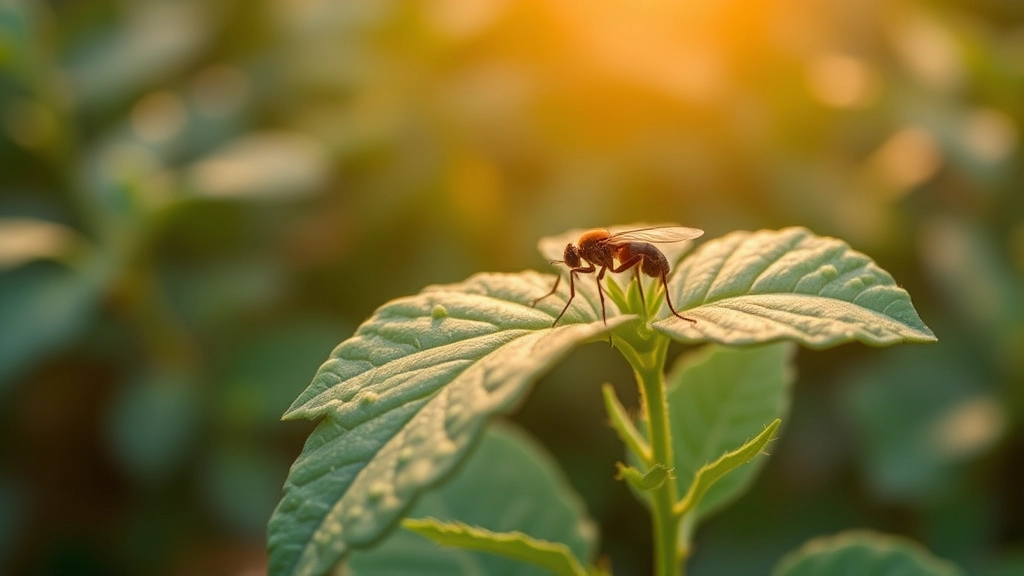
Alright, let’s talk about a real concern: preventing bugs without adding heat.
Nobody wants to be a mosquito buffet, right?
But who wants to sweat it out under a heavy bug net or with sticky insect repellent?
Here’s how to keep those pesky critters at bay without turning up the heat.
Choose the Right Campsite
First things first, pick your spot wisely.
- Avoid areas with standing water. That’s a breeding ground for mosquitoes.
- Opt for breezy locations. Bugs are terrible fliers in the wind.
Natural Repellents
Let’s keep it simple and natural.
- Citronella candles: They smell good and keep bugs away.
- Essential oils: Lavender, eucalyptus, and peppermint are great. Mix a few drops with water and spray it around.
Clothing Choices
Covering up doesn’t mean sweating buckets.
- Lightweight, long-sleeved shirts and trousers: They protect your skin and keep you cool.
- Light colours: Bugs are more attracted to dark colours. Go light and stay cool.
Bug-Proof Your Tent
Your tent can be your sanctuary.
- Mosquito net: A must-have. Lightweight and effective.
- Seal your tent: Make sure there are no gaps. Bugs are sneaky.
Timing Is Everything
Bugs have their schedules too.
- Dusk and dawn: Peak mosquito times. Plan your activities accordingly.
- Midday: Fewer bugs. Enjoy the sunshine.
DIY Bug Spray
Make your own bug spray. It’s easy.
- Mix water, witch hazel, and a few drops of essential oils.
- Spray it on your skin and around your campsite.
Keep Food Sealed
Bugs love food as much as we do.
- Airtight containers: Keep food sealed to avoid attracting bugs.
- Clean up: Don’t leave crumbs or spills. Bugs will find them.
Stay Hydrated
Believe it or not, staying hydrated helps.
- Drink plenty of water: It keeps your body cool and less attractive to bugs.
- Avoid sugary drinks: They attract insects.
Cool Down with Technology
Sometimes, a little tech goes a long way.
- Battery-operated fans: They keep the air moving and bugs away.
- Portable bug zappers: Effective and satisfying.
Share Your Stories
Got a funny or frustrating bug story?
Share it with us.
We all have them, and sometimes, a good laugh is the best repellent.
Cooling Down Before Bedtime: Showers and Towels
Ever tried to fall asleep in a tent that’s hotter than a sauna? It’s brutal, right? Cooling down before you hit the sack is crucial for a good night’s sleep during summer camping. Let’s dive into some practical tips to help you chill out before bedtime.
Why Cooling Down Matters
First off, why bother cooling down before bed? Simple. Your body needs to drop its core temperature to fall asleep. If you’re overheated, you’re in for a restless night. So, how do we tackle this?
Quick Cool-Down Strategies
1. Cold Showers
One of the best ways to cool down fast is a cold shower. It might sound basic, but it works wonders. Here’s why:
- Drops Core Temperature: A cold shower helps lower your body’s core temperature, making it easier to fall asleep.
- Refreshes the Skin: It washes away sweat and grime, leaving you feeling fresh and clean.
Pro Tip: If you’re camping somewhere without shower facilities, no worries. A simple basin of cold water can do the trick. Just splash yourself down, and you’re good to go.
2. Wet Towels
No shower? No problem. Wet towels are your new best friend.
- Dampen a Towel: Soak a small towel or cloth in cold water.
- Apply to Pulse Points: Place it on your wrists, neck, or forehead. These areas have blood vessels close to the skin, so cooling them can help lower your overall body temperature.
3. Cooling Towels
Invest in a cooling towel. These bad boys are designed to stay cool for hours. Just wet, wring, and snap. Wrap it around your neck or lay it on your chest for instant relief.
Combining Techniques
Sometimes one method isn’t enough. Mix and match these strategies for maximum cool-down:
- Shower + Wet Towel: Take a cold shower and follow up with a wet towel on your pulse points.
- Cooling Towel + Fan: Use a cooling towel and set up a portable fan in your tent. The airflow will enhance the cooling effect.
Real-Life Example
Let me tell you about the time I camped in the Sahara Desert. Yeah, it was as hot as it sounds. My buddy and I were struggling to sleep in the sweltering heat. We didn’t have access to showers, but we did have a couple of towels and a basin of water. We soaked the towels, draped them over ourselves, and set up a battery-powered fan. It wasn’t perfect, but it made a world of difference. We went from tossing and turning to catching some solid Z’s.
Internal Links
For more tips on staying cool while camping, check out our section on Summer Camp Packing Checklist and Summer Camp Care Packages.
Safe Outdoor Cooking Without Adding Heat
Ever tried cooking outdoors in the blazing heat and felt like you were in a sauna?
Yeah, me too.
Let’s talk about how we can cook safely without turning our campsite into an oven.
Why It Matters
When it’s hot outside, the last thing you want is to make it hotter.
Cooking over an open flame or a hot stove can spike the temperature and make you miserable.
Plus, it’s a safety hazard.
Cool Cooking Methods
Here are some ways to keep your meals cool and your campsite safe:
- Cold Meals:
- Salads: Easy and refreshing. Think pasta salads, fruit salads, and veggie mixes.
- Sandwiches: Simple, no-cook, and filling.
- Wraps: Versatile and can be packed with proteins and veggies.
- Pre-Cooked Meals:
- Home-Cooked: Prepare meals at home and just reheat them.
- Canned Foods: Beans, soups, and stews that only need a quick warm-up.
- Solar Cooking:
- Solar Ovens: Use the sun’s energy to cook food. No flames, no extra heat.
- Solar Bags: Perfect for heating water or cooking simple meals.
- Portable Grills:
- Charcoal Grills: Keep them away from your tent. Use them for quick grilling.
- Gas Grills: Easier to control and less heat spread.
Safety First
Cooking outdoors comes with its own set of risks.
So, here’s how to stay safe:
- Fire Safety: Always have a bucket of water or a fire extinguisher nearby.
- Distance: Keep cooking equipment away from tents and flammable materials.
- Ventilation: Cook in an open area to avoid smoke and fumes.
Smart Gear
Invest in gear that makes outdoor cooking a breeze:
- Portable Coolers: Keep your ingredients fresh and your drinks cold.
- Insulated Containers: Great for keeping food hot or cold.
- Compact Stoves: Small, efficient, and less heat output.
Real-Life Example
Last summer, my mate Tom and I went camping during a heatwave.
We relied heavily on cold meals and a solar oven.
Not only did we stay cool, but we also enjoyed some of the tastiest meals without breaking a sweat.
For more tips on how to have a fun and safe summer camp experience, check out our Ultimate Summer Camp Schedule Template Guide and explore more about what summer camp is like in our Comprehensive Guide to Summer Camp.
FAQs on Camping in Summer Heat
What kind of tent is best for summer camping?
For summer camping, opt for lightweight tents with plenty of ventilation. Look for tents with mesh panels and large windows to ensure good airflow.
What sleeping gear should I use in hot weather?
Choose a lightweight, breathable sleeping bag or a sleeping bag liner. Sometimes, a simple sleeping pad and a light blanket can be more comfortable.
How can I keep my tent cool?
Using a battery-operated fan can significantly improve airflow. Setting up your tent in a shady, breezy spot and opening all windows and vents also helps.
What should I wear for summer camping?
Choose clothes made from breathable fabrics like linen or synthetic blends that wick away sweat. Light colours are preferable as they reflect heat.
How can I stay hydrated while camping in the heat?
Carry a hydration pack or a large water bottle and drink water regularly to stay hydrated.
What are some DIY cooling techniques for camping?
Simple DIY methods include using ice packs and a fan, hanging damp towels inside your tent, and using a reflective tarp to deflect sunlight.
How can I protect myself from the sun while camping?
Wear a wide-brimmed hat, sunglasses, and apply sunscreen regularly to protect yourself from the sun.
What cooking gear is best for hot weather camping?
A portable stove is ideal as it keeps the heat away from your tent and is more efficient than a campfire.
How can I prevent bugs without adding heat?
Use natural repellents like citronella candles and essential oils, wear lightweight, long-sleeved clothing, and ensure your tent is properly sealed with a mosquito net.
Why is ventilation important in a tent?
Proper ventilation keeps you cool, prevents condensation, and helps you sleep better. Look for tents with multiple mesh panels, windows, and vents.
What are some effective cooling gadgets for camping?
Consider using a cooling towel, a battery-operated fan, and portable bug zappers to stay cool and comfortable.
How can I ensure good airflow in my tent?
Set up your tent in a breezy, shaded area, prop up the rainfly if it’s not raining, and keep all doors and windows open during the day for maximum airflow.
References
-
Summer Camping Tips: Stay Cool and Comfortable
-
How to Stay Cool While Summer Camping
-
Summer Camping Tips: How to Beat the Heat

